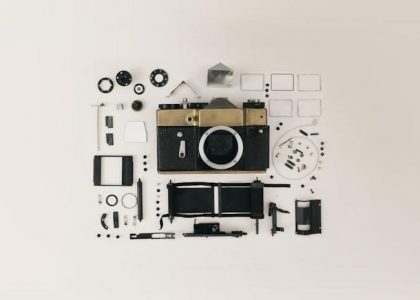The Nikon D3100, released in 2010, is an entry-level DSLR camera designed for beginners and hobbyists. It features a 14.2MP CMOS sensor, HD video recording, and user-friendly controls.
1.1 Key Features of the Nikon D3100
The Nikon D3100 features a 14.2-megapixel CMOS sensor, offering sharp images with excellent color accuracy. It supports full HD video recording at 1080p (24fps) and manual focusing for creative control. The camera includes multiple shooting modes, such as Auto, Scene, and Manual modes, catering to both beginners and enthusiasts. Its ISO range extends from 100 to 3200, with an optional Hi setting for low-light conditions. The D3100 also includes an 11-point autofocus system, a 3-inch LCD screen, and compatibility with SDHC/SDXC memory cards.
1.2 Target Audience and Usage Scenarios
The Nikon D3100 is ideal for photography beginners and hobbyists seeking to enhance their creative skills. Its intuitive interface and automatic modes make it perfect for casual shooters. The camera is also suitable for enthusiasts looking to transition from point-and-shoot to DSLR. It excels in various scenarios, including travel photography, family events, and everyday moments. Lightweight and portable, the D3100 is a great tool for capturing high-quality images with minimal complexity, making it an excellent choice for those new to DSLR photography;
Getting Started with the Nikon D3100
Unboxing and setting up the D3100 involves charging the battery, installing the lens, and inserting a memory card. Basic configurations include setting the language, date, and time.
2.1 Unboxing and Initial Setup
When you unbox the Nikon D3100, you’ll find the camera body, battery, charger, USB cable, and user manual. Begin by charging the battery fully before use. Next, install the provided lens or your preferred option. Insert a compatible SD/SDHC/SDXC memory card into the slot. Power on the camera and navigate through the initial setup menu to select your language, set the date and time, and choose video mode (NTSC/PAL). These steps ensure your camera is ready for basic operation.
2.2 Charging the Battery and Installing the Lens
The Nikon D3100 comes with a rechargeable EN-EL14 lithium-ion battery. To charge it, connect the battery to the supplied MH-24 charger and plug it into a power outlet. Allow it to charge fully before first use. For the lens, align the white dots on the lens and camera mount, then twist gently to secure. Ensure the lens clicks into place. If using an optional lens, follow the same alignment process. Always power off the camera before changing lenses to prevent damage.
2.3 Basic Camera Settings and Configuration
After unboxing and charging, insert the battery and memory card. Power on the camera and set the date, time, and language. Navigate to the shooting menu to configure basic settings like image quality (JPEG/RAW) and autofocus modes. Set the shooting mode to Auto for beginners or Program mode for more control. Adjust the ISO sensitivity and white balance as needed. Familiarize yourself with the information display for quick adjustments. Ensure all settings are saved before proceeding to capture your first shots. Proper configuration ensures optimal performance.
Understanding the Camera’s Design and Layout
Insert the battery and memory card, then set date, time, and language. Navigate to the shooting menu to configure image quality, autofocus, ISO, and white balance. Save settings and start shooting in Auto or Program mode for optimal results.
3.1 Overview of the Camera Body and Controls
The Nikon D3100 features a compact, ergonomic design with intuitive controls. The camera body includes a mode dial, LCD screen, and viewfinder for easy navigation. Key controls like the shutter release, multi-selector, and command dial are strategically placed for comfort. The 3-inch LCD screen provides clear previews and menu access, while the optical viewfinder offers precise framing. This layout ensures easy operation, making it ideal for both beginners and experienced photographers to explore creative possibilities effectively.
3.2 Key Components and Their Functions
The Nikon D3100 features a 14.2MP CMOS sensor for crisp images, a 3-inch LCD screen for previewing shots, and an optical viewfinder for precise framing. The mode dial on top allows quick access to shooting modes, while the command dial adjusts settings like aperture and shutter speed. The kit lens (18-55mm VR) offers image stabilization, and the multi-selector enables easy menu navigation. Additional controls include the D-pad for autofocus and the live view button for video recording. These components work together to enhance functionality and user experience.
3.3 Ergonomics and User-Friendly Features
The Nikon D3100 boasts an ergonomic design with a contoured grip for comfortable handling. Its intuitive button layout ensures easy access to key controls, while the lightweight body makes it portable. The 3-inch LCD screen provides clear preview and playback. Features like Live View and an intuitive menu system cater to beginners, offering guided settings for easy operation. Dedicated buttons for ISO and autofocus modes simplify quick adjustments, enhancing the overall user experience.
Shooting Modes and the Mode Dial
The Nikon D3100 features a mode dial offering various shooting options, including Auto, Scene, and Manual modes, allowing users to capture photos with ease and precision.
4.1 Auto Modes (Auto and Auto without Flash)
The Nikon D3100 features two Auto modes: Auto and Auto without Flash. These modes are designed for beginners, allowing the camera to automatically adjust settings for optimal results. In Auto mode, the camera controls exposure, focus, and ISO, making it ideal for quick, point-and-shoot photography. The Auto without Flash mode disables the flash, preserving natural lighting and reducing glare. Both modes are perfect for everyday photography, ensuring sharp, well-balanced images with minimal effort.
4.2 Manual Modes (Program, Shutter Priority, Aperture Priority, Manual)
The Nikon D3100 offers four Manual modes for advanced control: Program, Shutter Priority, Aperture Priority, and Manual. In Program mode, the camera adjusts settings automatically but allows customization. Shutter Priority lets you set the shutter speed, ideal for freezing or blurring motion. Aperture Priority enables control over aperture for depth of field. Manual mode offers full control over both shutter and aperture. These modes cater to experienced photographers, providing flexibility for creative expression and precise control over image capture.
4.3 Scene Modes and Specialized Shooting Options
The Nikon D3100 features Scene modes tailored for specific shooting scenarios, including Portrait, Landscape, Close-up, and more. These modes optimize camera settings for ideal results in various conditions. Additionally, the camera offers Specialized Shooting Options, such as the Guide Mode, which simplifies complex settings for beginners. The D3100 also supports RAW file format for superior image quality and offers advanced options like noise reduction and autofocus fine-tuning. These features enhance flexibility for photographers seeking more creative control.
Focusing and Metering
The Nikon D3100 offers autofocus modes for precise subject tracking and manual focus for creative control. It also features advanced metering modes to ensure balanced exposures.
5.1 Autofocus Modes and Manual Focus
The Nikon D3100 features autofocus modes for sharp and precise subject capture. Single-servo AF (AF-S) is ideal for stationary subjects, while continuous-servo AF (AF-C) tracks moving objects. Manual focus (MF) allows for fine-tuned control, enabling creative depth-of-field adjustments. The camera also supports live view autofocus for accurate focusing during video recording. These modes ensure versatility, catering to both beginners and advanced photographers aiming for professional results.
5.2 Metering Modes (Matrix, Center-Weighted, Spot)
The Nikon D3100 offers three metering modes to ensure accurate exposure. Matrix metering analyzes the entire scene for balanced results. Center-weighted metering prioritizes the central area, ideal for portraits; Spot metering measures a specific point, useful for high-contrast lighting. These modes provide flexibility, helping photographers achieve precise control over exposure in various conditions. Each mode caters to different shooting scenarios, ensuring optimal image quality.
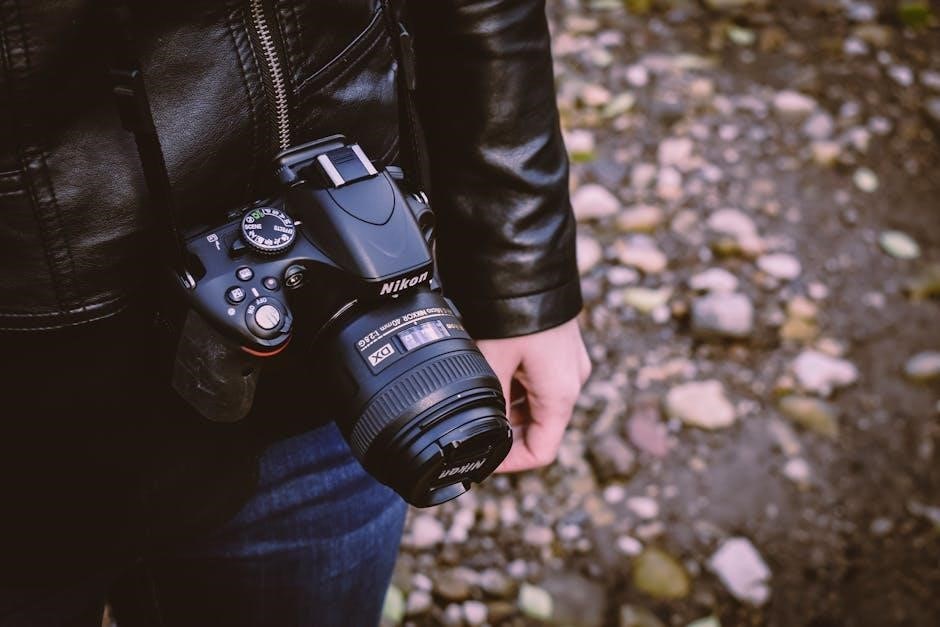
White Balance and ISO Settings
The Nikon D3100 offers tools to enhance image quality. White Balance ensures accurate colors in various lighting conditions, while ISO settings (100-3200) manage low-light sensitivity and noise reduction.
6.1 Understanding White Balance and Preset Options
White Balance adjusts colors to match lighting conditions, ensuring accurate tones. The Nikon D3100 offers presets like Auto, Daylight, and Tungsten, plus manual mode (PRE) for custom settings. This feature enhances image realism by eliminating unwanted color casts.
6.2 ISO Sensitivity and Noise Reduction
The Nikon D3100 features an ISO range of 100 to 6400, enabling photography in various lighting conditions. Higher ISO settings, such as 6400, can introduce noise, but the camera includes built-in noise reduction to minimize grain. This feature is particularly useful in low-light situations, helping to preserve image quality. Balancing ISO sensitivity and noise reduction settings is key to achieving sharp, detailed photos with minimal digital artifacts.
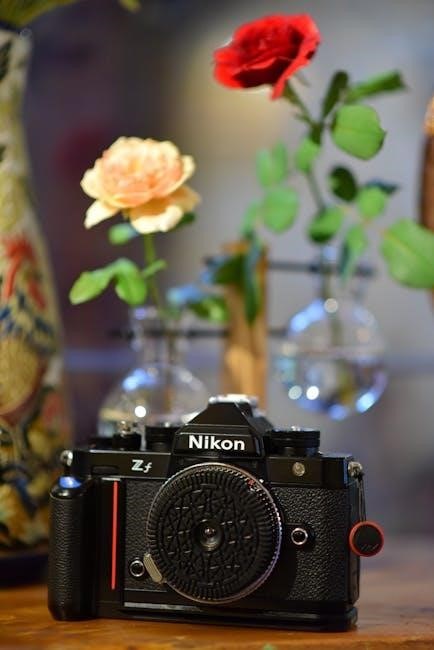
Memory Cards and File Formats
The Nikon D3100 supports SDHC and SDXC memory cards, offering ample storage for photos and videos. It records images in JPEG, RAW, or video formats, ensuring flexibility and quality in capturing moments.
7.1 Compatible Memory Cards (SDHC/SDXC)
The Nikon D3100 is compatible with SDHC and SDXC memory cards, offering storage capacities from 4GB up to 128GB or more. These cards provide ample space for storing high-resolution photos and videos. SDXC cards, in particular, support larger storage needs, making them ideal for extended shooting sessions or when capturing HD video. Ensuring compatibility with these cards is essential for efficient data management and optimal camera performance.
7.2 File Formats (JPEG, RAW, and Video)
The Nikon D3100 supports multiple file formats, including JPEG for compressed images, RAW (NEF) for uncompressed files, and video in MOV format. JPEG is ideal for everyday use, offering smaller file sizes and quick sharing. RAW files provide maximum image detail and flexibility for post-processing. For video, the D3100 records in Full HD (1080p at 24fps) using H.264 compression, ensuring high-quality footage with efficient storage. These formats cater to both amateur photographers and videographers, offering versatility and professional-grade output.
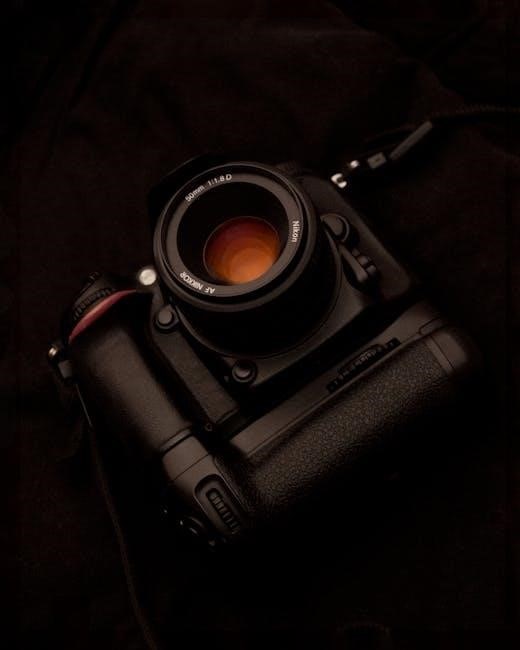
The Menu System
The Nikon D3100 features an intuitive menu system with options like Shooting, Playback, Setup, Retouch, and Recent Settings. Navigate using buttons for easy customization and adjustments.
8.1 Navigating the Shooting Menu
The Shooting Menu on the Nikon D3100 offers options to customize image settings. Users can adjust Quality, White Balance, and ISO Sensitivity. The Picture Control feature allows for personalizing color profiles. Additional options include Active D-Lighting for better contrast and Auto Distortion Control to reduce lens distortion. These settings can be accessed via the Menu button, enabling quick adjustments to enhance image quality. The menu is user-friendly, making it easy to optimize camera settings for various shooting conditions.
8.2 Playback and Setup Menus
The Playback Menu allows users to review and manage captured images. Functions include deleting unwanted photos, rotating images, and creating slideshows. The Setup Menu provides options for customizing camera settings, such as date/time, language, and auto shutdown. It also includes tools for formatting memory cards, cleaning the sensor, and updating firmware. These menus are essential for maintaining and personalizing the camera, ensuring optimal performance and organization of your photos.
8.3 Retouch and Recent Settings Menus
The Retouch Menu offers in-camera editing options, allowing users to enhance photos without a computer. Features include D-Lighting for improving shadows, Red-eye correction, and Trim for cropping images. The Recent Settings Menu provides quick access to the most recently adjusted settings, streamlining workflow. These menus simplify post-capture adjustments and customization, making it easier to refine photos and settings directly on the camera.
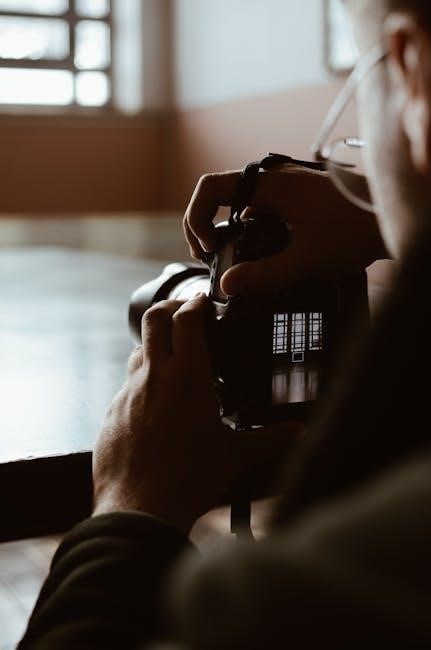
Custom Settings and Personalization
The Nikon D3100 allows users to customize camera controls, assign functions to buttons, and manage user profiles for quick access to personalized settings.
9.1 Customizing Camera Controls and Buttons
The Nikon D3100 allows users to customize camera controls to suit their preferences. Assign functions to buttons like the Fn button for quick access to settings such as ISO or white balance. Additionally, users can customize the AE-L/AF-L button to suit their shooting style, enabling features like AF lock or exposure lock. This level of customization enhances workflow efficiency and personalizes the camera experience.
9.2 Managing Preset Settings and User Profiles
The Nikon D3100 allows users to save and manage preset settings for quick access. By creating user profiles, photographers can store preferred configurations, including shooting modes, autofocus settings, and ISO sensitivity. This feature is particularly useful for switching between different photography styles or conditions. Preset settings can be easily recalled via the camera’s menu system, ensuring efficiency and consistency in various shooting scenarios. This customization option enhances the camera’s versatility for diverse photographic needs.

Shooting Techniques and Tips
Mastering the Nikon D3100 involves understanding its autofocus modes, metering options, and composition techniques. Experiment with different settings to enhance your photography skills and capture stunning images.
10.1 Basic Shooting Techniques for Beginners
For those new to photography, the Nikon D3100 offers intuitive modes to simplify the learning process. Start with the Auto mode for point-and-shoot convenience, ensuring well-balanced exposures. Pay attention to composition by using the rule of thirds and leading lines. Properly hold the camera to avoid shake, and use the built-in flash for low-light conditions. Familiarize yourself with the autofocus system to achieve sharp images. Practice these techniques to build a solid foundation in photography.
10.2 Advanced Techniques for Better Photography
To enhance your photography skills, experiment with manual modes like Aperture Priority (A/Av) and Shutter Priority (S/Tv) for precise control over depth of field and motion. Use the autofocus system effectively, switching between AF modes for dynamic subjects. Master metering techniques, such as spot metering, to handle challenging lighting. Adjust white balance for accurate color representation and manage ISO settings to minimize noise. For video, focus manually and use external microphones for better audio. Practice these advanced methods to elevate your Nikon D3100 photography.
Video Recording and HD Capabilities
The Nikon D3100 supports Full HD video recording at 1080p with a frame rate of 24fps, offering cinematic quality. Manual focusing during video shooting enhances creativity.
11.1 Full HD Video Recording (1080p at 24fps)
The Nikon D3100 offers Full HD video recording at 1080p with a frame rate of 24fps, delivering a cinematic look to your footage. This feature makes it ideal for capturing high-quality videos with a professional feel. The camera allows manual focusing during recording, enabling precise control over the subject. However, it lacks continuous autofocus in video mode, which may limit its use for fast-moving subjects. Despite this, the D3100’s video capabilities are impressive for its class, making it a great choice for creative projects.
11.2 Manual Focusing and Video Shooting Tips
Manual focusing during video recording on the Nikon D3100 allows for precise control over your subject. Use the lens focus ring to adjust sharpness smoothly. For best results, enable manual focus before starting recording to avoid accidental shifts. Stabilize the camera with a tripod to minimize shake. Ensure proper lighting and compose your frame carefully. Using an external microphone can enhance audio quality. These tips help maximize the D3100’s video capabilities, producing professional-looking footage with manual control.

Maintenance and Troubleshooting
Regularly clean the camera body and lens with a soft cloth to prevent dust buildup. For troubleshooting, reset the camera to factory settings or check for firmware updates.
12.1 Cleaning the Sensor and Camera Body
Regular cleaning ensures optimal performance and image quality. Use a soft, dry cloth to wipe the camera body and lens. For the sensor, activate the camera’s cleaning mode, then use a blower to gently remove dust. Avoid touching the sensor with fingers or objects. If using a cleaning solution, apply it only to the lens, not the sensor. Clean the viewfinder and LCD screen with a microfiber cloth. Always handle the camera with care to prevent damage during maintenance.
12.2 Common Issues and Solutions
Common issues with the Nikon D3100 include memory card errors, battery life problems, and autofocus inconsistencies. For memory card errors, ensure the card is properly formatted and free of corruption. Low battery life can be resolved by using original Nikon batteries and avoiding excessive use of the LCD screen. Autofocus issues may require recalibrating the lens or cleaning the sensor. For video recording problems, check that the camera is in HD mode and the memory card supports video recording. Regular firmware updates can address many performance issues. Always refer to the manual for troubleshooting guides.
The Nikon D3100 is a versatile DSLR camera offering excellent value for beginners. Its user-friendly design and advanced features make it ideal for capturing stunning photos and videos.
13.1 Summary of Key Features and Benefits
The Nikon D3100 offers a 14.2MP CMOS sensor, delivering crisp images with excellent low-light performance. It supports Full HD video recording at 1080p and features an intuitive interface. The camera’s compact design and lightweight body make it portable, while its advanced autofocus ensures sharp photos. With built-in Guide Mode, users can easily navigate settings, making it perfect for newcomers. Additionally, the D3100 supports various scene modes and manual controls, enhancing creative flexibility for photographers of all skill levels.
13.2 Final Tips for Maximizing the Nikon D3100’s Potential
To maximize the Nikon D3100’s potential, experiment with its shooting modes, such as Manual and Scene modes, to explore creative possibilities. Regularly clean the sensor and lens for optimal image quality. Utilize the camera’s HD video capabilities for capturing dynamic moments. Adjust ISO settings carefully to minimize noise in low-light conditions. Familiarize yourself with the menu system to customize settings for your photography style. Finally, practice with different techniques and review your work to refine your skills and unlock the full potential of your Nikon D3100.



